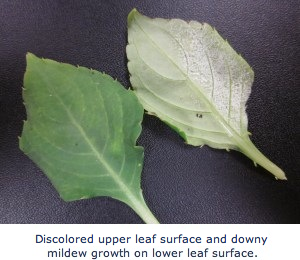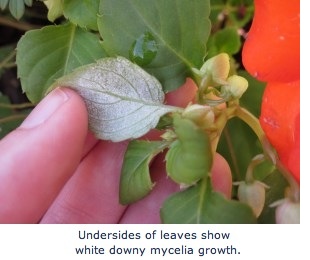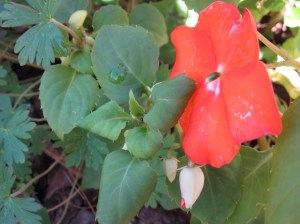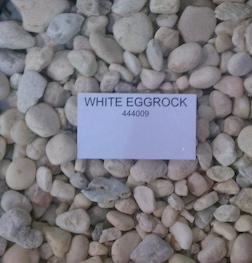Downy Mildew
on impatiens is currently a concern in South Florida. High humidity paired with cool nights created the perfect conditions for disease development. Downy mildews are caused by a variety of pathogens that tend to be specific to hosts; however Plasmopara obducens is the one that affects impatiens. Some literature indicates that downy mildew favors about 50 – 72 degrees Fahrenheit nighttime temperatures.

HOSTS
Downy mildew affects all hybrids and varieties of Impatiens walleriana, also called Busy Lizzy. New Guinea impatiens, Impatiens X hawkeri, is considered very tolerant. Counties adjacent to Palm Beach County have reported less severe outbreaks in 2011 and early 2012. Symptoms of downy mildew showing first on newer growth: leaf edges curling downward.
SYMPTOMS
Young plants and new growth are most susceptible and may show symptoms first. Initially, leaves may look a little yellowish or speckled. In fact, these symptoms look very similar to nutritional deficiencies. You may see faint gray lines on the tops of leaves or notice leaf edges curling downward. Sometimes the yellowing is not visible before leaf curling begins. As the disease continues to progress, whitish downy looking growth will be visible on undersides of leaves.This whitish growth is spore-containing structures that have emerged from the lower leaf pores (stomata). Next, leaves and flowers will drop quickly, leaving mostly stems.
LIFE CYCLE of the DISEASE
The pathogen that causes downy mildew is a type of water mold and is classified as more closely related to algae than to fungi. Other similarly classified pathogens include Phytophthora spp. and Pythium spp. Downy mildew can spread by two different types of spores. One type, zoospores, moves through water. They are also easily windborne when contained in a larger structure called a sporangium. This explains why this disease is spread by splashing overhead irrigation, rainfall and wind. The other type of spores, oospores, forms inside plant tissues where they can survive for years. Downy mildew is very aggressive and can rapidly spread, so be sure to act quickly if you spot it.

LANDSCAPE MANAGEMENT
This pathogen may erupt under high humidity, cool temperatures, and overcrowding. Overcrowding reduces the wind movement between plants that helps dry leaves more quickly. Prevention is the only effective management strategy. Elimination of overhead and nighttime watering, excessive fertilization, overcrowded planting beds, and other stresses on the plants would all be very helpful in avoiding or reducing occurrence of this pathogen. However, our tightly arranged mass planting practices in the landscape, irrigation systems, and periodic rainfall make this difficult to achieve. Be sure to carefully inspect impatiens leaves and stems purchased for the landscape before they are installed to help ensure that affected plants are rejected. Once in the landscape, the plants can be attacked by windborne spores, but it is always better to avoid bringing the pathogen in on plant materials.
Chemical treatments can be expensive and do not provide much curative function. They are much more effective when applied preventively. Quickly remove and dispose of plants or branches that appear to be affected by early symptoms of downy mildew. Follow quickly with recommended protective fungicide treatments. Be sure to fully remove as much plant tissue as possible from these beds in the spring when impatiens are changed to other flower varieties to avoid oospores surviving until the next time impatiens are planted. For replacement in heavily infested beds, consider selecting a resistant flower species or another type of plant.





